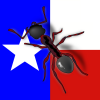Species 1:
Location of Collection: Desert Floor of Fort Stockton
Date of Collection: 5/25/19
Habitat: Shrubby Desert
Length: 5mm
Coloration: Red orange head and thorax. Upper left thorax is redish brown, while the remainder is red orange. Orange mandibles. Antenae start out orange and fade to black about half way. Legs start out redish brown and fades to orange past the femur. Abdomen is translucent dark yellow with redish brown stripes that do not go all the way down the abdomen.
Distinguishing Characteristics: One node.
Anything Else Destinctive: Colonies make long trails to nectar bearing plants or between nest sites on the desert floor. Very quick to find food. Sparatic and quick movements observed among workers. Queens are very quick runners as well.
Nest Description: Small hole in the ground. No scattered dirt or fresh dirt. Just a simple hole about 5mm in diameter.
Nuptial Flight Time: Not exactly sure, but I would assume May - July.
Pictures of Queen:




Species 2:
Location of Collection: Desert Floor of Fort Stockton
Date of Collection: 5/25/19
Habitat: Shrubby Desert
Length: 5.5mm
Coloration: Black head and antenae. Orange mandibles. Midthorax is redish brown all the way down and the remainder of the thorax is black. Black femurs with the remainder of the leg fading to orange. Dark yellow abdomen with redish brown stripes that do not go all the way down the abdomen.
Distinguishing Characteristics: One node. Body elongate.
Anything Else Destinctive: No workers observed. Two queens were found roaming the desert floor and one was captured.
Nest Description: N/A
Nuptial Flight Time: Not exactly sure, but I would assume May - July.
Pictures of Queen:

















